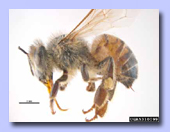 |
 |
 |
|
|
 |
When is the optimum time for cranberry growers to get bees for pollination? |
|
Lesson Plan: Overview
|
As a fruit-producing plant, the cranberry requires pollination of its blossoms. Without pollination, no fruit will form. The cranberry flower’s main pollinator is the bee. On commercial bogs, honey bees – originally imported to North America from Europe in the 1600’s – are typically the primary pollinator. Two honey bee hives (the equivalent of up to 80,000 bees) are required for every acre of cranberries. Hives are rented and usually arrive at the bog towards the beginning of summer. As a rule of thumb bees should arrive when 10% of the pods have blossomed. A pod is the bud-like state of the cranberry flower before it blooms. The pod’s appearance changes over time from a small, completely closed form to an elongated form just before it is a mature flower. The honey bees forage for nectar, which they convert to honey. They also seek pollen, which supplies their protein needs. As bees visit blossoms, their bodies brush against flower parts, picking up and dropping off pollen. In this way, their foraging results in pollinated blossoms. These bees are sensitive to adverse weather conditions and will not visit the plant during a rainstorm or high wind. Unlike the honey bee, the bumblebee is native to America and served as the original cranberry pollinator. The bumblebee is a very efficient pollinator but, because the colony is considerably smaller than the honey bee colony (200-300 bees per hive) it is used as a supplemental pollinator. Less impacted by poor weather conditions, the bumblebee will pollinate in the rain. Although honey and bumble bees are critical to cranberry pollination, it is nonetheless very important that the grower not keep the bees on the bog too long. Otherwise, once the peak cranberry bloom has passed, bees will move on to visit and pollinate other plants, including unwanted weeds such as goldenrod. This lesson includes a graph that illustrates this idea. It’s important to note that, as a simplified model, it does not necessarily correlate to specific weeds and specific dates. Instead the graph has been kept simple so that students can grasp the main idea.
|
| Credits |